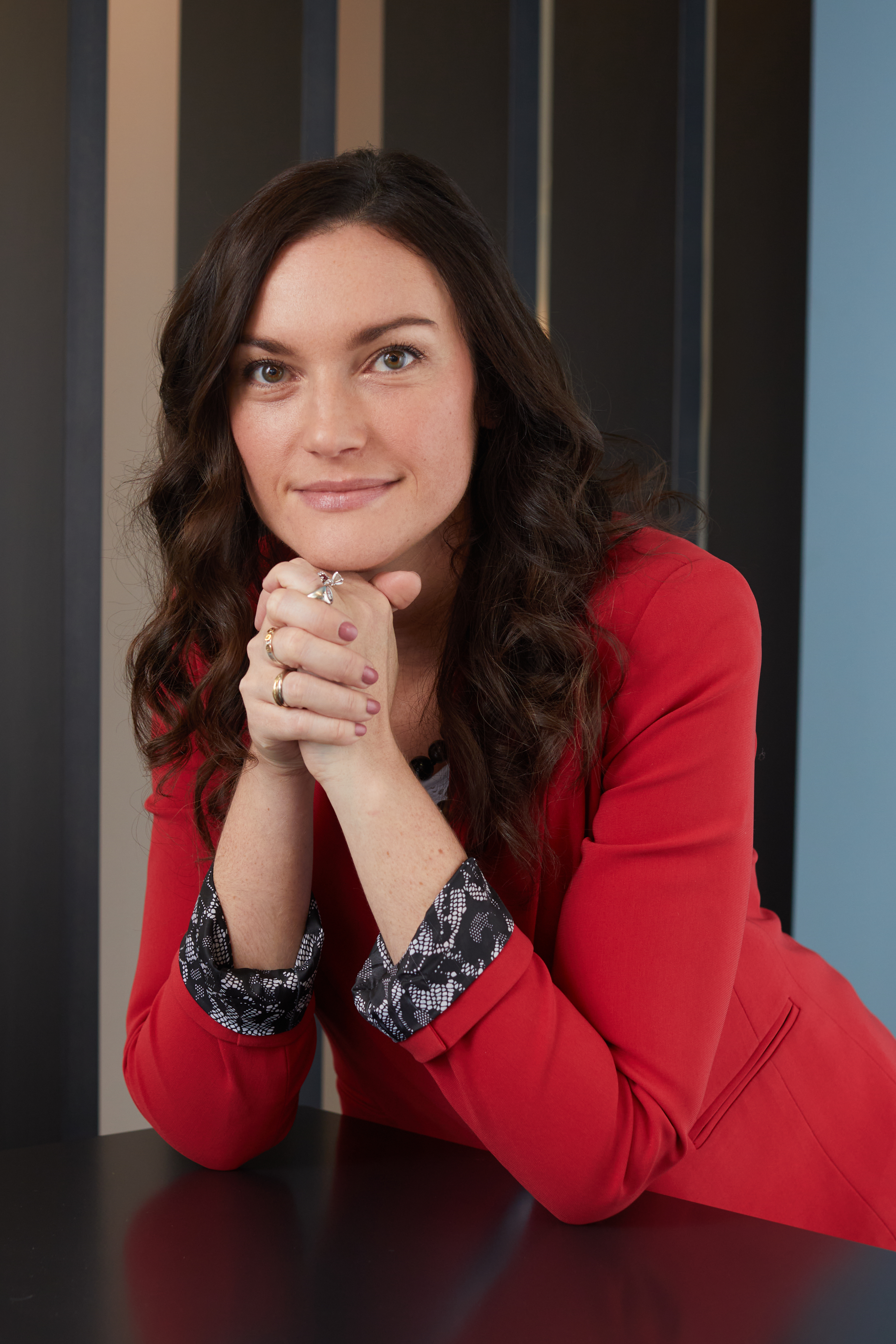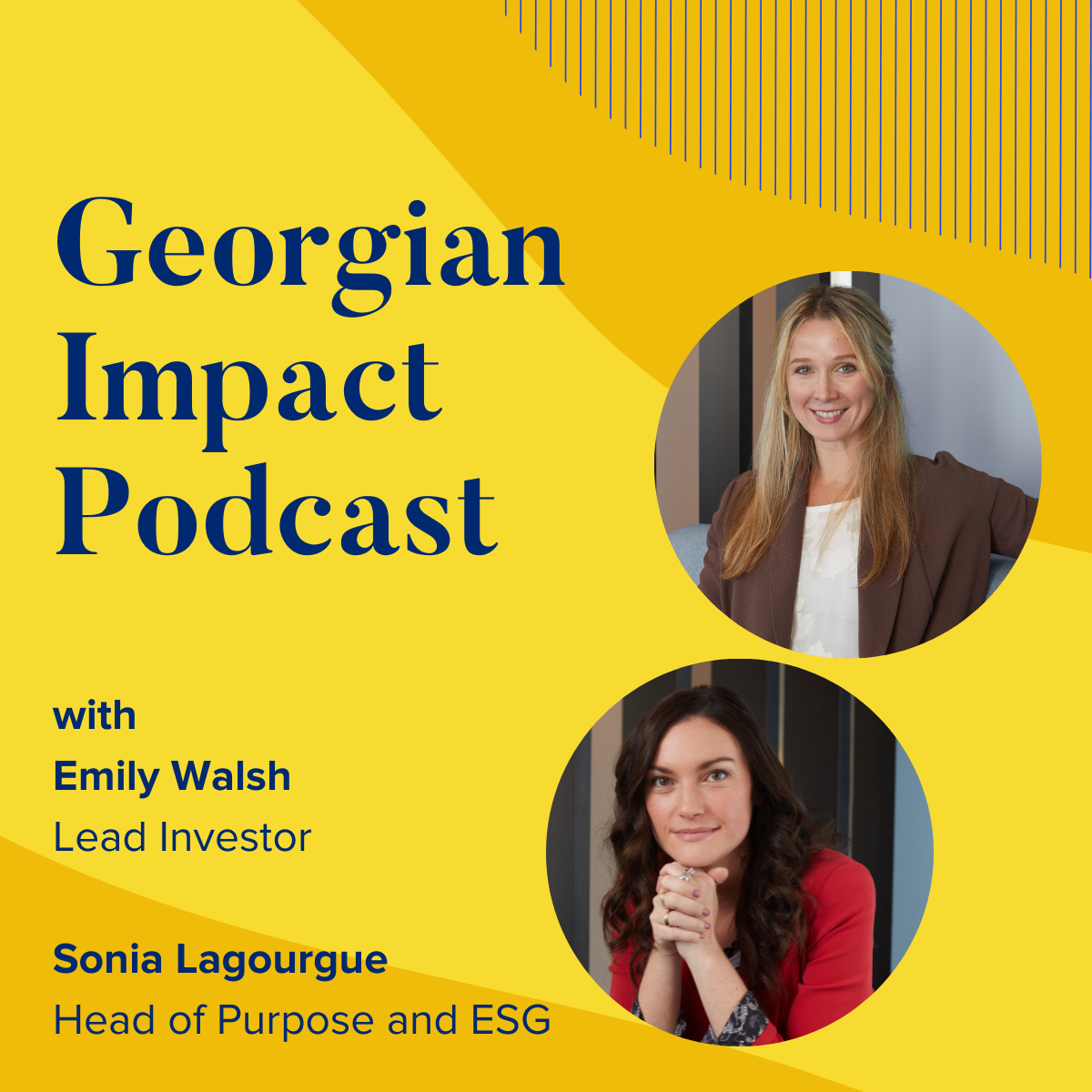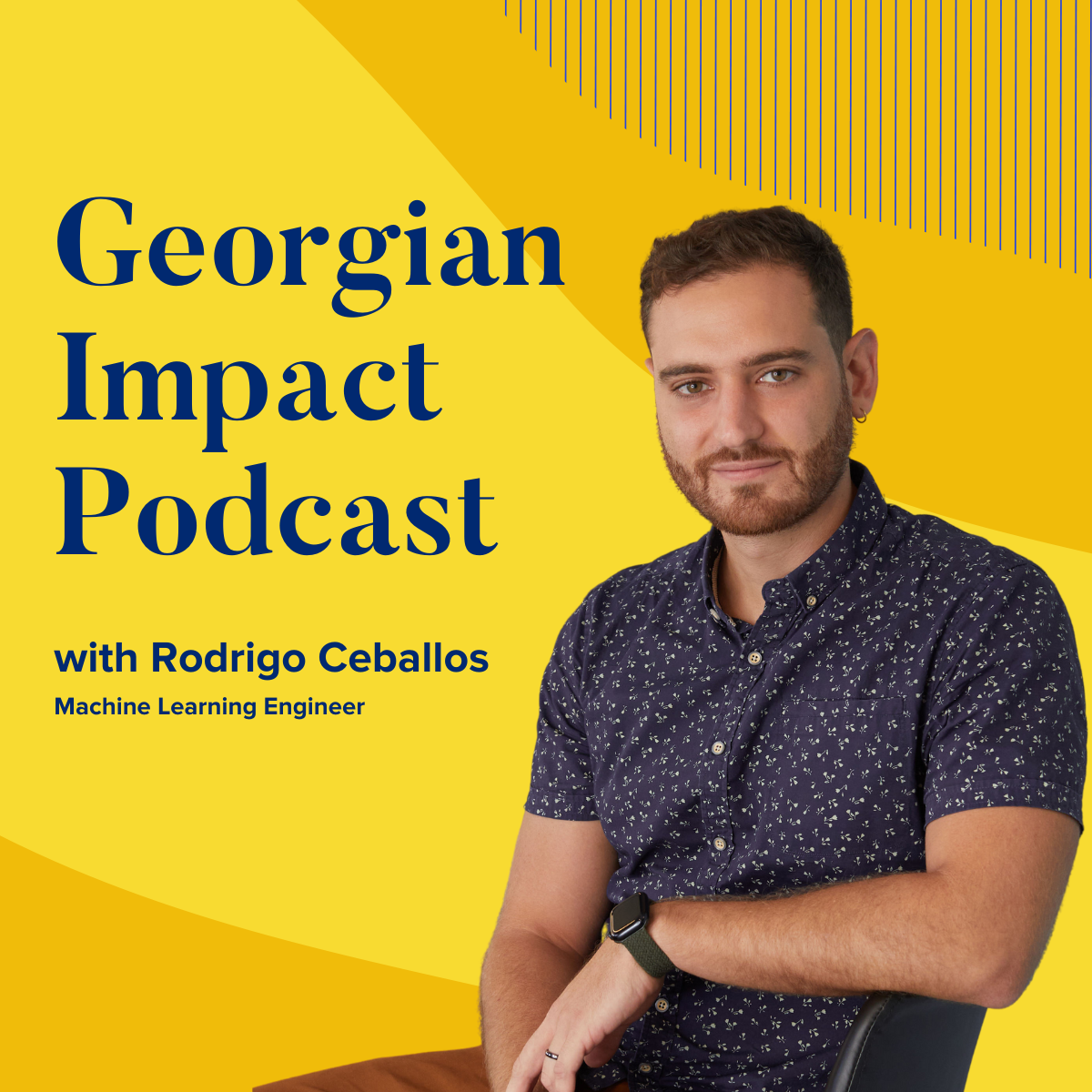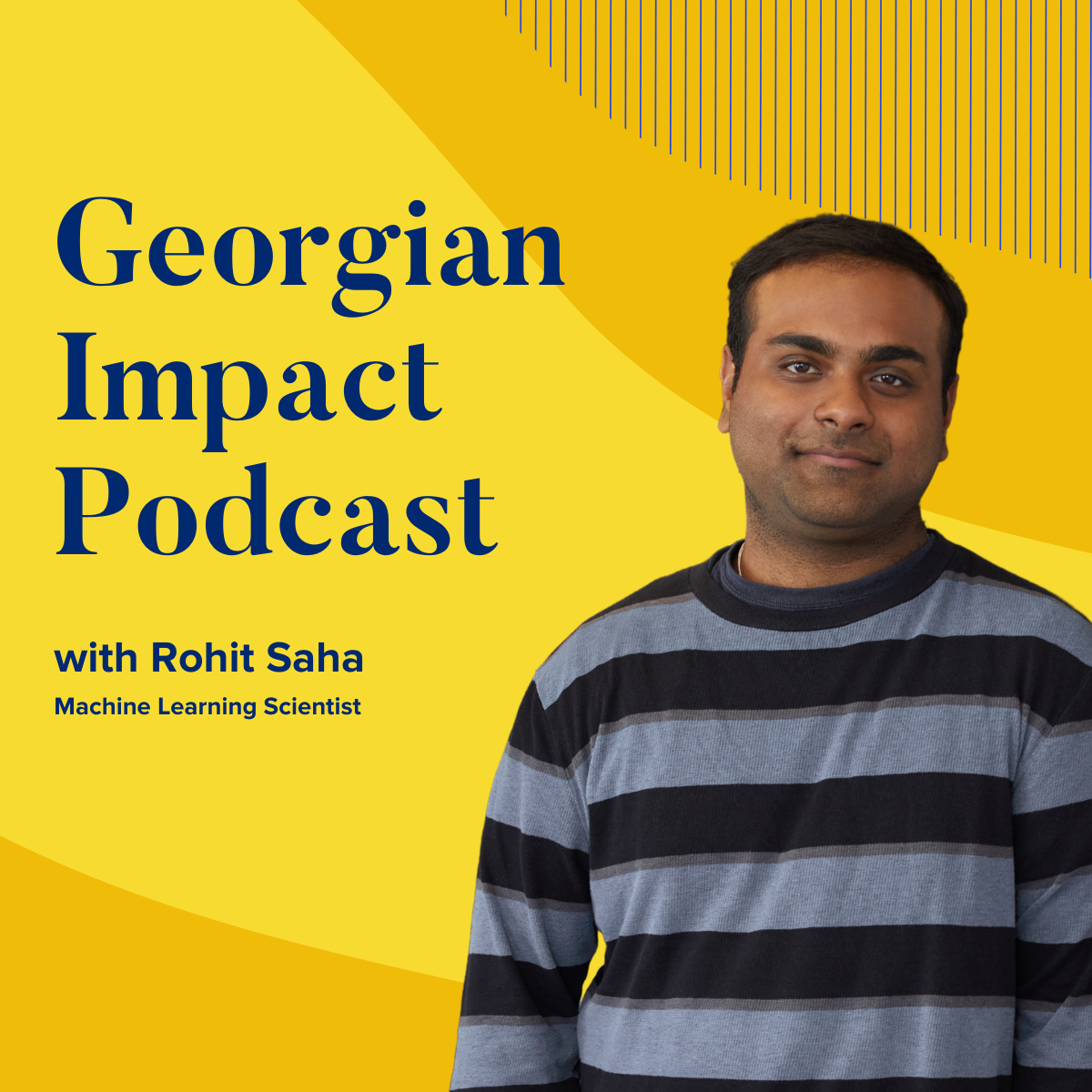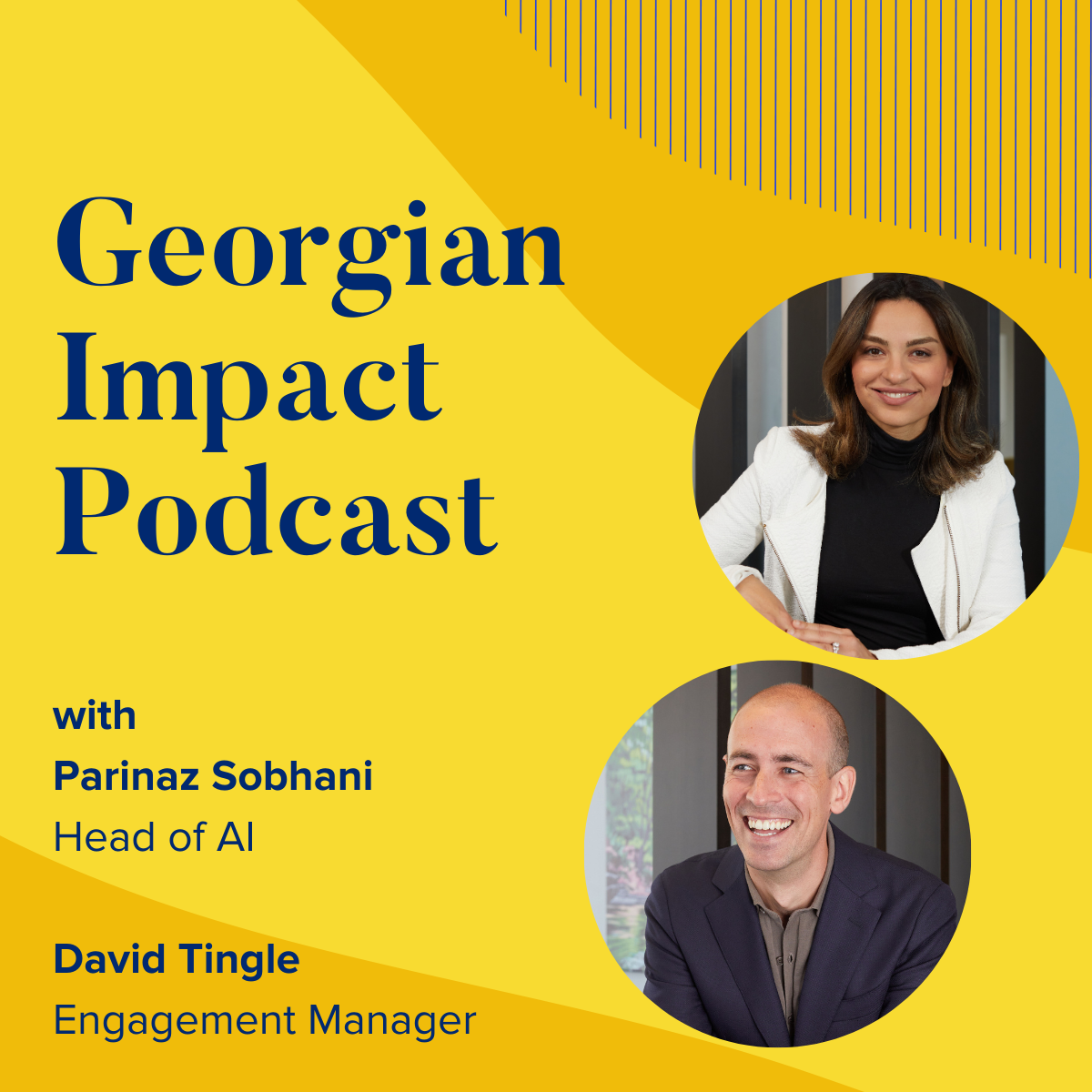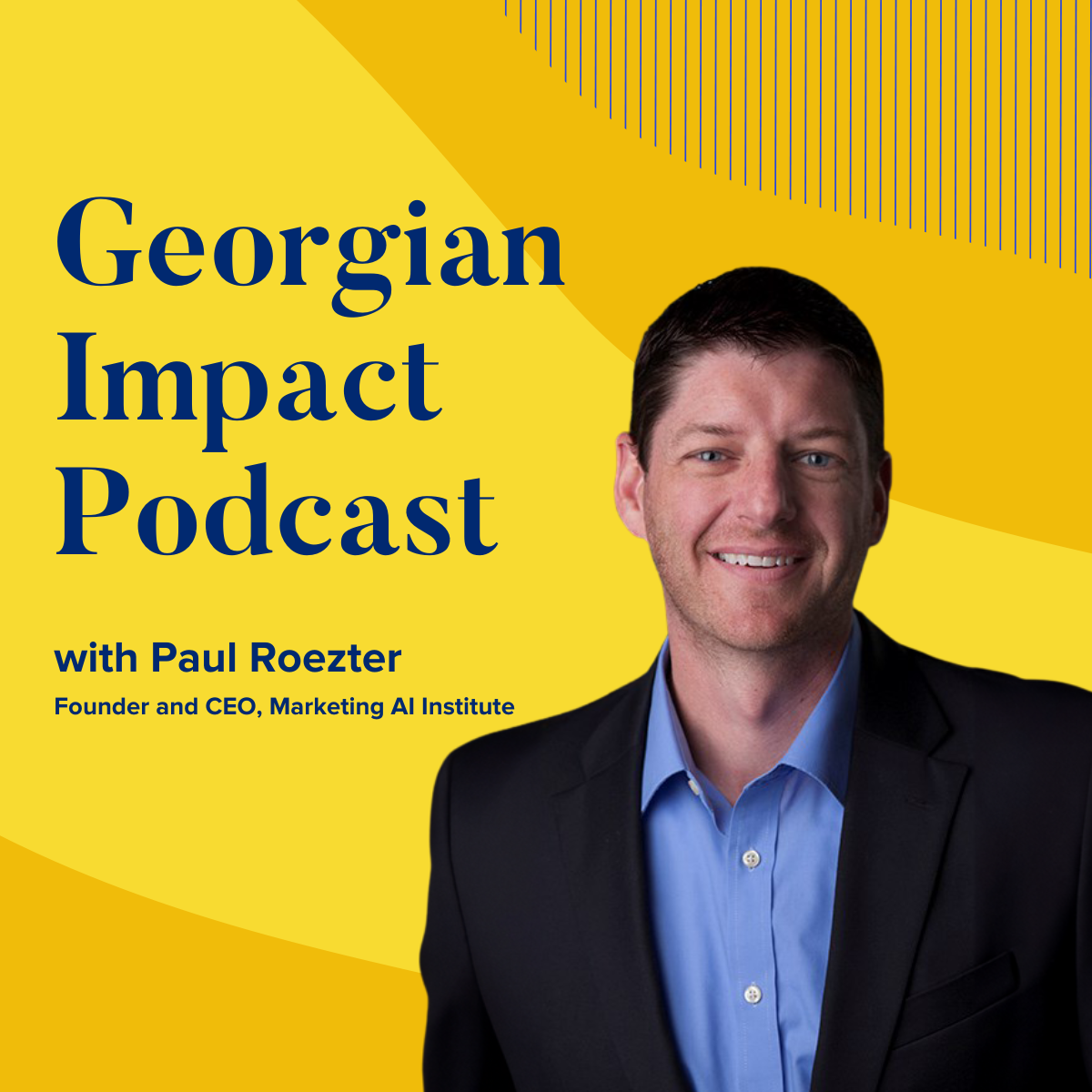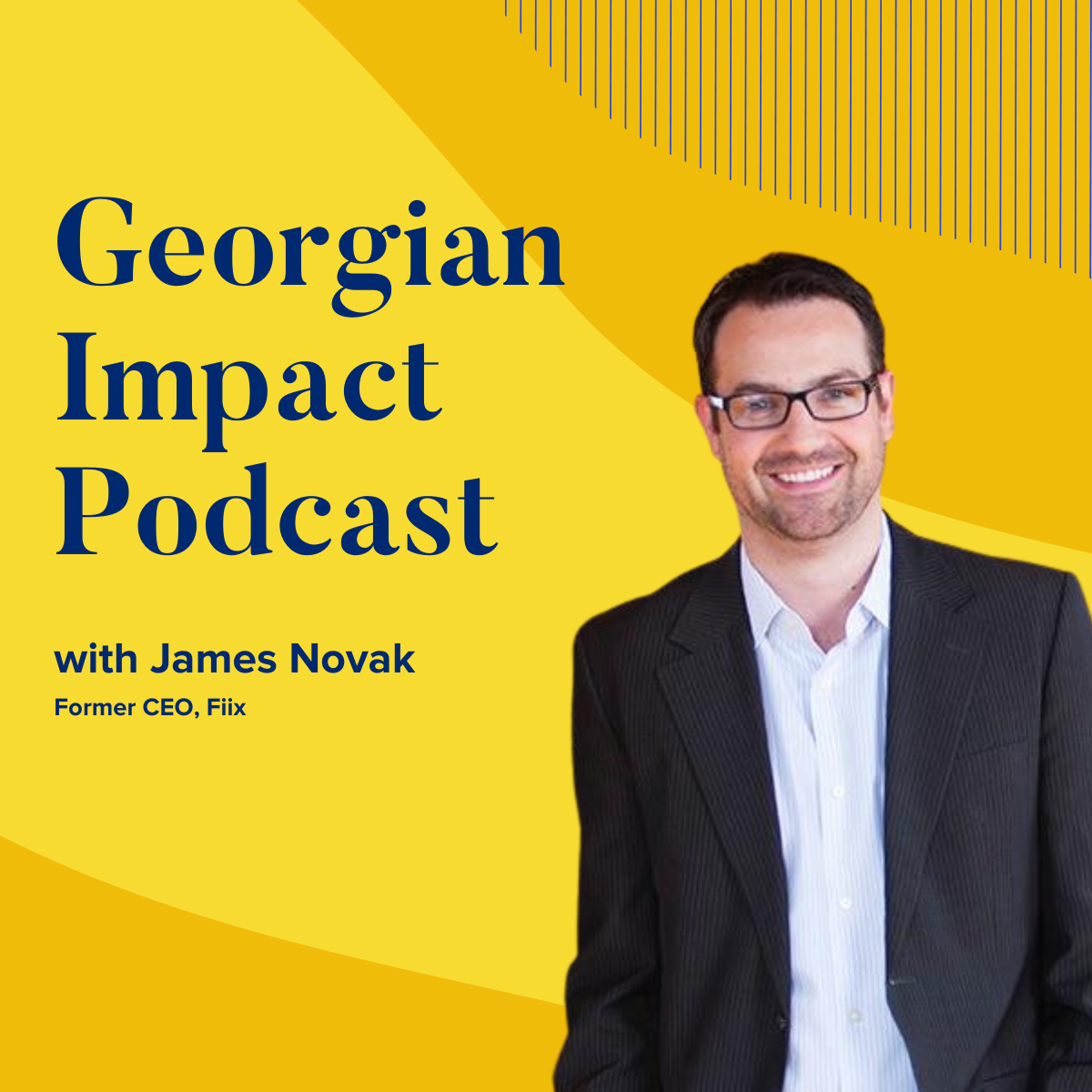Why Georgian launched a Product-led Purpose thesis
- 0.5
- 1
- 1.25
- 1.5
- 1.75
- 2
Jon Prial: The material and information presented in this podcast is for discussion and general informational purposes only, and is not intended to be and should not be construed as legal, business, tax, investment advice, or other professional advice. The material and information does not constitute a recommendation, offer, solicitation or invitation to the sale of any securities, financial instruments, investments, or other services, including any securities of any investment fund or other entity managed or advised directly or indirectly by Georgian or any of its affiliates. The views and opinions expressed by any guests are their own views and does not reflect the opinions of Georgian. Since our inception, Georgian has identified new trends that we believe will change the way companies do business. This kind of thinking resulted in our thesis areas, like applied AI, conversational AI and trust. Recently, we launched our latest thesis area, product- led purpose. Simply put, product- led purpose is our view that the next generation of market leading technology companies that will not only deliver economic value, but also a quantifiable positive impact on societal challenges. We see that companies embedding a purpose within the product can create value for customers and advance their purpose. In the same vein, we also officially launched our purpose, which is to maximize participation in the digital economy. Now, there are two intersecting stories about Georgian and how we do business, and we've got two Georgian leaders to unpack them. Sonia Lagourgue, Georgian's Head of ESG, and Emily Walsh, Lead Investor at Georgian. Together, they're going to be covering what Georgian's purpose is and how we live it through our product- led purpose thesis. To get started, Sonia's going to explain our purpose and what it takes to get the entire Georgian team engaged with it.
Sonia Lagourgue: Thanks, Jon. Georgian recently announced a purpose statement, and it's something that we launched both internally with our teams and with their input and also externally on our website and through our report for all of our other stakeholders. And what we categorize as something that's particularly important and inspiring to us as a purpose statement is to maximize participation in the digital economy. I think when that statement was first introduced by our leadership team, there was a lot of enthusiasm across the organization to understand what that really means, both in terms of how do we interpret that and speak to it and share it, but also how do we live that from a day- to- day perspective in our roles, in our jobs and how we engage with our customers and just the community around us. So we spent quite a bit of time internally in the organization making sure that every single person that works at Georgian felt connected to that statement, knew how to interpret it, and knew how to bring it into their day- to- day environment.
Jon Prial: So why was it so important to engage the entire Georgian team and how exactly do we make sure everyone's connected to it and participated?
Sonia Lagourgue: One of the things that I think was really important to us when we crystallize this purpose is to make sure that everybody at Georgian felt connected to it and felt like they understood it and what it meant to them and what they do. And so that they could maximize their participation in how they embrace the statement and really apply it, right? Because if it's just a sentence on a piece of paper, it's not really going to do anyone a lot of particular goods. So it was really important for us that the 100 people that work here each really pick that up and live it day to day. So one of the things that we did is to take the guidance from the leadership team and the statement that they provided based on their vision and their experience and where Georgian has been to date, and then really engage with those words and make meaning from them and interpret them as individuals on each team. And then we came together through a variety of different sessions and really add interpretation to that to make meaning. And it was really powerful for me to hear the team and what they saw and the close alignment that actually came out of that exercise with what the leadership team initially intended and how each individual person, how we all were so closely aligned in our interpretations. And the three key factors that the 100 people that work here came back with and said, " This is what maximize participation in a digital economy means to us, and this is how we plan to apply it in our day- to- day work."
Jon Prial: So talk me through those three factors, please.
Sonia Lagourgue: Those three key things were around access. So making sure that technology is accessible and inclusive of people who have historically been underrepresented or have faced maybe additional barriers to being engaged in the tech sector as creators, as employees, or even as users. So that deep recognition, that tech is not made equally for all and not all can equally access tech and benefit from it. So that was the first thing, access. The second thing was around knowledge, right? We live in the information age, probably over information at this point. But making sure that that knowledge around how to leverage information, how to generate more information or knowledge and put it out in the world, how to capitalize on that if you are a creator and making sure you're not being left out and how to build skill and build talent and kind of reinvest that back into that tech labor market, it was around enabling that. So first access, then knowledge and making sure that you are a viable contributor and that you are not kind of the use case. You are the user, not the use case. And then the last part was around empowerment, is leveraging those two components so now that people have access and now that they are informed and are tech literate, that they can really empower themselves and their environment to benefit, to shift and influence where technology is going, where the digital economy is going, and making sure that they are not being left behind. And so having that kind of expanded interpretation of our purpose statement made it real for each and every one of us. And then we've been doing more and more brainstorming about how do we reintroduce that into our actual roles at Georgian and bring it out into the world as useful tools, as processes or the way that we engage with our customers.
Jon Prial: Yep. Georgian's been around for a long time. I was part of it. But Emily, I want to dig deeper into our purpose, this maximizing participation of the digital economy and understand how that idea came about. And is there a tie to Georgian's history?
Emily Walsh: Georgian's been around for 15 years and the concepts behind this purpose statement have been important to us for 15 years. I think when Georgian was founded, the group that came together to really form the beginnings of Georgian cared very much about improving diversity in the tech sector and maximizing who got to benefit from the tech sector. And our purpose today as articulated today, is really built on those foundational principles. And over our 15- year history, we've done a number of things both internally and externally, that really speak to that. For example, in 2012, we formed a partnership with an organization at the time, called Ladies Learning Code, in our community. We were some of the early kind of supporters of that group, which is really about getting women in into coding and into technology. What we saw from an investing standpoint is that there's incredible jobs, there's incredible companies being built. There's a lot of money being made in the tech sector and more people should have access to it. Ladies Learning Code over the past 10 years or so has grown into Canada Learning Code. It's provided hundreds of thousands of technology experiences to Canadians of all backgrounds and demographic origins, and it's had a huge impact on promoting the technology industry as a career of choice for people in Canada. Some of those principles have really been important to Georgian for a very long time. Internally, one of the things we wanted to do was build a very diverse team.
Jon Prial: It's great that you wanted to build a diverse team, and obviously, you have to be very intentional about it. How'd you go about doing that?
Emily Walsh: Back in 2014, we started a very simple design choice really in our hiring funnels where we said we want an equal number of male and female candidates at final stage interviews. And that, over time, is a very simple choice, but it's led to us having about 50/ 50 gender split in Georgian. And even more than gender split, we have something like 25 languages spoken at Georgian, tons of different passports. It's just an incredibly diverse team, which is quite rare in the investing industry. So those are maybe a couple of things that we've done internally in our community. And then as we think about the greater stakeholder groups that Georgian touches on our investor side, we've thought very carefully about who do we want to invest in Georgian and how can we over time expand that pool of people and institutions to maximize who gets to benefit from the growth equity industry and what we believe to be a very great asset class to be a part of.
Jon Prial: There's something we've been doing to hold ourselves accountable, our Higher Purpose Report. For the audience, our Higher Purpose Report is report we do every year on how exactly we've increased participation in the digital economy, we made local communities better and so much more. It's now called the Purpose Report, and we'll be releasing our 2022 report soon. Emily, tell us more though, about how we bring our purpose to action.
Emily Walsh: Our first Higher Purpose Report was in 2019, and we introduced it as a way to start cataloging the things that we were doing, both internally, how we were running our business, as well as what we were seeing in our customer base, the companies that we've invested in, initiatives that we were running in the community, partnerships that we were forming, and ways, for example, that we were looking to diversify our funnel of companies that we could potentially invest in. So we had formed a number of partnerships with incubators that focused on diverse founders and how are we bringing those founders closer to the Georgian community over time? So those are the types of things that we were looking to share. And also in addition to sharing, to keep ourselves accountable, to put data down each year and to put goals for the upcoming year, and then to catalog those things over time and to see are we improving, are we getting better, is our data improving over time? We started by just saying reporting on people at Georgian and what's our attrition rate? What are our demographics statistics? And over time, in 2020, for example, we did our first ESG survey across our portfolio of customers, and that was the first time that we reported on a portfolio level kind of how are things going. So it established a first baseline, and Sonia's done a remarkable job kind of building on that first instantiation over the past couple of years. And that's kind of the next evolution of where this report is going is more data, more accountability, more target setting, and more opportunity for us to track and improve our performance over time.
Jon Prial: All right, so let's dive more than into the thesis of product led purpose. Now, you can all read our blog about it, which we'll put in the show notes. But this is a new thesis. We publicly launched it in January. So I'd like to have Emily explain it. Emily, tell me why we launched a product- led purpose thesis and really what does it mean?
Emily Walsh: So the impetus for product- led purpose really came out of our own purpose of maximizing participation in the digital economy. And when we think about that, it's how can we get more people to benefit from tech? And when we think about what's our biggest lever to doing that as an organization, we're 100 people at Georgian. We're not a huge company here. But, if we look across all of the companies that we invest in and will invest in, you're talking about thousands and thousands of people. And even more than the people who work at those companies, products that reach millions of people, that impact millions of people. And that also because we're investing in the business software industry, products that are not only touching individual people but are powering really, really important decisions. They're powering decisions like who gets a loan? What's your health insurance premium cost? What is your mortgage look like? What insurance programs are you allowed to be eligible for? Those types of decisions today are powered by technology more often than not. And we're investing in the companies that make those decisions. And so when we think about equity, fairness, impact from technology and the positive sense, it really ties down to product/ what are the companies that we invest in doing out there in the world with their products and who is being impacted? Who is benefiting from those products?
Jon Prial: So you mentioned finance, you mentioned investments, I didn't hear climate. Now, is that part of it? Could it be part of it?
Emily Walsh: For sure. But I think that one of the core tenets of this thesis is that it's not specific to an industry. We're not going down the impact route of saying, " We're investing in companies that help the environment. We're investing in companies that help diversity." We're investing in all of business software and we're investing in companies that appreciate the impact of what their products are doing regardless of industry or specific endpoint. Shopify, a former Georgian portfolio company, is a great example of what we mean when we say product- led purpose. They went out there and they said, " We want everyone to have the access to the internet to sell. We want to empower entrepreneurs regardless of their technological sophistication globally." And that reach has led to, I think they have something like five million jobs that are supported by Shopify and the technology that they have out there globally. So we thought about it. It's not an industry focus, it's really any business software because that's the world we invest in. Any business software company can and should think about the way they grow, the way they build product from a purpose lens.
Jon Prial: Emily, I want to talk about other companies. You talked a bit about Shopify. But talk a bit about companies where you've seen the strong top level executive focus on purpose and how it's really motivated and driven the companies forward.
Emily Walsh: Sure. I'll talk about Fiix, which was a Georgian investment. They exited to Rockwell Automation about a year and a half ago. And Fiix was a company that was creating solutions for manufacturers to do predictive maintenance on their machinery. And so they were selling to a very diverse array of manufacturers and they were basically saying, " You need to fix this machine. This machine needs maintenance, this one's not working properly, check this part." And the team there was quite inclined to look at what were the impacts around the economic benefit that their customers were certainly seeing from the software. And one of the things that they really cared a lot about was the environment. And the case they built around this was really that not only were they seeing quantitative impact of economic benefit by maintaining machines better, you have to replace them less often if you take care of them, makes sense. But they were also seeing by maintaining machines better, you were able to reduce the electrical consumption that it took to operate those machines, the energy overall that it took to operate those machines from any source. You were able, by prolonging the life of individual assets, able to reduce waste in the factory environments. There are all sorts of external benefits to the economic story. External, but tied to the economic story because it obviously saves the factory money if they don't have to replace the machine in addition to it being an environmental benefit. So what Fiix did? And this was very holistic undertaking. They tacked, quantitatively, the impact, both the economic and environmental impacts of their software. And they had partners through local universities that helped to build out those studies and make sure that they were validated and could be relied upon. And then they built a lot of things internally that tied their employee value proposition to this mission around helping to improve climate outcomes. And this was super successful for the business, both in terms of who the employees that they were able to attract and retain, and they had one of the highest retention rates that we saw of companies in similar kind of size and stage. And also from a customer perspective. And I think this is a very important point that's kind of core to this whole thesis on product- led purpose, Fiix sold to manufacturers of all shapes and sizes. Some of them cared a lot about the environmental impact of their factories. Some of them didn't care so much about the environmental impact of their factories. I think the important thing that Fiix saw was that regardless of their customer's preference, the product had the same impact across the board. People did not buy, necessarily, Fiix software because it was an environmental help. They bought it because it was a great product and it also drove better in environmental outcomes across the entire customer base, regardless of what those customers leanings were on the environment, which is sometimes a hard conversation to go down. So that was very successful. This whole strategy around Fiix was something that we looked at very closely as we were developing the thesis on product- led purpose. And James Novak, the CEO at the time of exit, was a very close partner to Sonia and myself as we were kind of in the formation stages of this thesis because he had been there, done that. And we took a lot of the concepts that Fiix learned through this journey and embedded them into how we were thinking about this thesis area. So that's one example that's very close to home.
Jon Prial: Not to put words in your mouth, but I want to take this to the next level. I want to really get kind of nitty- gritty here. Our assumption has been, as with all of our thesis areas, companies make a commitment around product- led purpose and then we expect that they'll have happier customers and better business results. The good business measurements, is this still a fair assumption?
Emily Walsh: We believe that this is, for a many reasons. You can look at this in an internal lens and we absolutely do as well. Employees today want to work at companies that have purpose, that have meaning, that have a why behind what they do. So if you think about this from an internal operational perspective, this is also about attracting and retaining the best employees. You're going to be better at that, if you think about your business with a purpose at the core. And then if you think about the impact of those products, I think one of the genius things about Shopify was that by taking this really expansive view, which started with a purpose, which started with this belief that anybody could sell online, it allowed them to think bigger about where their product could go and what it could do. And what they did very strategically was pushed down the barriers to entry for new users on their platform, better than anybody else they were competing against. So I think we believe, this is not an altruistic model of growing, this is an economic model of growing.
Jon Prial: So Emily, take me through the pillars, the main pillars of the product- led purpose thesis.
Emily Walsh: Foundationally, this starts with having purpose. So I think this all stems from a company, and usually this starts with the CEO, the founders of the organization, clearly articulating an ambitious and relevant goal purpose. The second piece is how are you going to use that purpose to guide your strategy as an organization? What does that mean, going back to the Shopify example, for what markets you want to play in for, how you want to compete, for what product you're ultimately going to build? And then it tracks down into the actual product piece, and what are you developing? How are you going to track the impact of your product? Have you thought through to our earlier conversation around trust and security, all of the implications around that? And then of course, there's a piece of this thesis that's very much about how do you run your business? And we considered that. And this is kind of where a lot of the conversation around ESG really lives is in the operations of the business. We think of this as very much, yes, you can create value from ESG, but it's also a foundation. It's a bedrock of defensive posturing for the business. Because the worst possible situation you could get yourself into as a company is to be out there touting all of the great things you're doing and then actually internally be treating your people terribly, or having bad environmental practices or having poor governance and having fraud in your business, for example. So that operational piece is very important. It's very much a cornerstone of the thesis, even though the trust is really around what's the product you're building, how are you tracking the impact, how are you capturing that impact and then feeding it back into the organization to improve the product over time. So those are some of the main pieces. Sonia, feel free to add on.
Sonia Lagourgue: I think the last pillar is around kind of talent and people and making sure that you're creating that virtual cycle of making your purpose in both an inspiring and actionable component, and then eventually just becoming the default in how people think and feel and operate within the company. And then that becomes an attraction lever. It enables you to actually continue to deliver on the purpose because if your people aren't bought in, inspired and are not applying it, the chances of you executing on your purpose become that much harder. I think one of the things that I was really excited and in that framework that we realized could be a unique opportunity is how closely purpose can be connected to innovation. Because when you have your existing product... the other thing I think that's important to flag is that this isn't just a square one thing. If you already are a company in market with a product, with a defined ICP, all of those things, and you've got a lot of adoption, that doesn't mean that you can't use this thesis as well, that you can't think about integrating that into how you operate today. So there's definitely a unique aspect if you're kind of like a purpose native and you're starting from scratch, it could be a great framework to consider and use those building blocks from square one. But they can also be retroactively applied, I think, very successfully. And one of the things that, as I mentioned, I'm particularly excited is the innovation angle that this can introduce. When a company figures out its purpose and starts to have those types of conversations with their stakeholders, I think what could happen is they're going to introduce new aspects into their strategy, into their go- to- market, into their talent pipeline, whatever have you. You're going to start to attract people that think in line with what you've said your purpose is. And when those people come into your funnel, whichever funnel that is, whether it's a sales funnel or a talent funnel, they're going to bring new requirements with them, and they're going to bring new ideas about how to solve problems with them. And what that's going to arm companies with is a net new set of specifications with which to build. So now you might have a new target market, you might have a new customer segment, you might have ideas for additional or net new product features. And when you create those, you can test them with your existing customers or you can test them with this new set of potential customers and create that value added feedback loop for what you are able to build, where you are able to sell it, how you are able to channel it. And that's just like a blue ocean, if you will. It's a brand new field for the organization of where they can play and win.
Jon Prial: There's a natural tension between pushing technology and purpose. And we're seeing that today with the advent of a lot of the new AI technologies in generative AI. And of course in terms of large machines running and potentially impacting climate and the like, how does this get reconciled, Emily, in terms of ensuring companies keep their eye on their purpose and also build the product?
Emily Walsh: Everything that's happening in the machine learning, the AI debates that we're seeing very publicly right now, it's a lot of questions that people have about the direction that technology is heading. We see product- led purpose as really the foundation of what will make the next great technology companies in this next 5, 10, 15 years. We believe that the next Amazon, Google, Microsoft, that company is going to be built using this type of thesis that thinks of not only about the economic impact of what they're building, although that is obviously foundational to building a major company, but what exactly that product is doing in the world. And that ties back to trust, that ties back to what's the world that we want our children to live in. That ties back to these bigger questions around what is the ultimate impact of technology in our world? And that impact should be good because technology has such an incredible power to transform our world and to make people's lives better. And we see this as this being the next generation of great technology companies. This is how they're going to be built. This is how leaders will think about what matters most. Everything from the kind of culture, the kind of place you want to create for people to work at, your employees are going to want to work at a company that's doing good in the world to exactly what that thesis ties back to, which is what is the impact of your product out there? What is it doing? Who's it affecting? What decisions is it driving and how is it thinking about all of these very fundamental principles of equity, access, and fairness in the world? So those are some of the kind of foundational pieces that we think about and why we think this is such an important area for us to be focusing on as we think about the thesis areas that are going to drive the next set of investment decisions for Georgian.
Jon Prial: Awesome, thank you for that. And thank you both for the really insightful discussions of what it means to be a purpose- led company and our latest thesis. If you want to learn more, check out our blog in the show notes. We also have a podcast episode from former Fiix CEO, James Novak, where he talks about the company's own journey to a product- led purpose and how Fiix's customers and their employees really embrace it. Great story, great success. For the Impact Podcast, I'm Jon Prial.
DESCRIPTION
Since our inception, Georgian has identified new trends that we believe will change the way companies do business. This kind of thinking resulted in our thesis areas like Applied AI, Conversational AI and Trust.
In this episode of the Georgian Impact Podcast, we talk to Sonia Lagourgue, Georgian’s Head of Purpose & ESG and Emily Walsh, Lead Investor at Georgian. They will break down Georgian’s latest thesis area: Product-led Purpose.
Simply put, Product-led Purpose is our view that the next generation of market-leading technology companies will not only deliver superior economic value but also a quantifiable positive impact on societal challenges.
You’ll Hear About:
● Georgian’s purpose and what it takes to get the whole team engaged.
● Where the purpose came from and its ties to Georgian’s history.
● How Georgian’s Purpose Report holds us accountable.
● Why Georgian launched a Product-led Purpose thesis and what that really means.
● How a strong top-level executive focus on purpose can motivate and drive a company forward.
● The main pillars of the Product-led Purpose thesis.
● The natural tension between pushing technology and purpose.
Today's Host
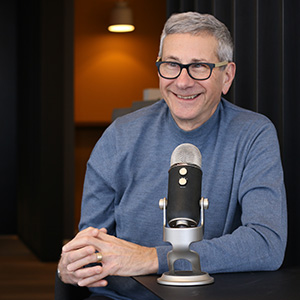
Jon Prial
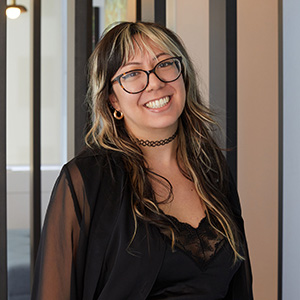
Jessica Galang
Today's Guests
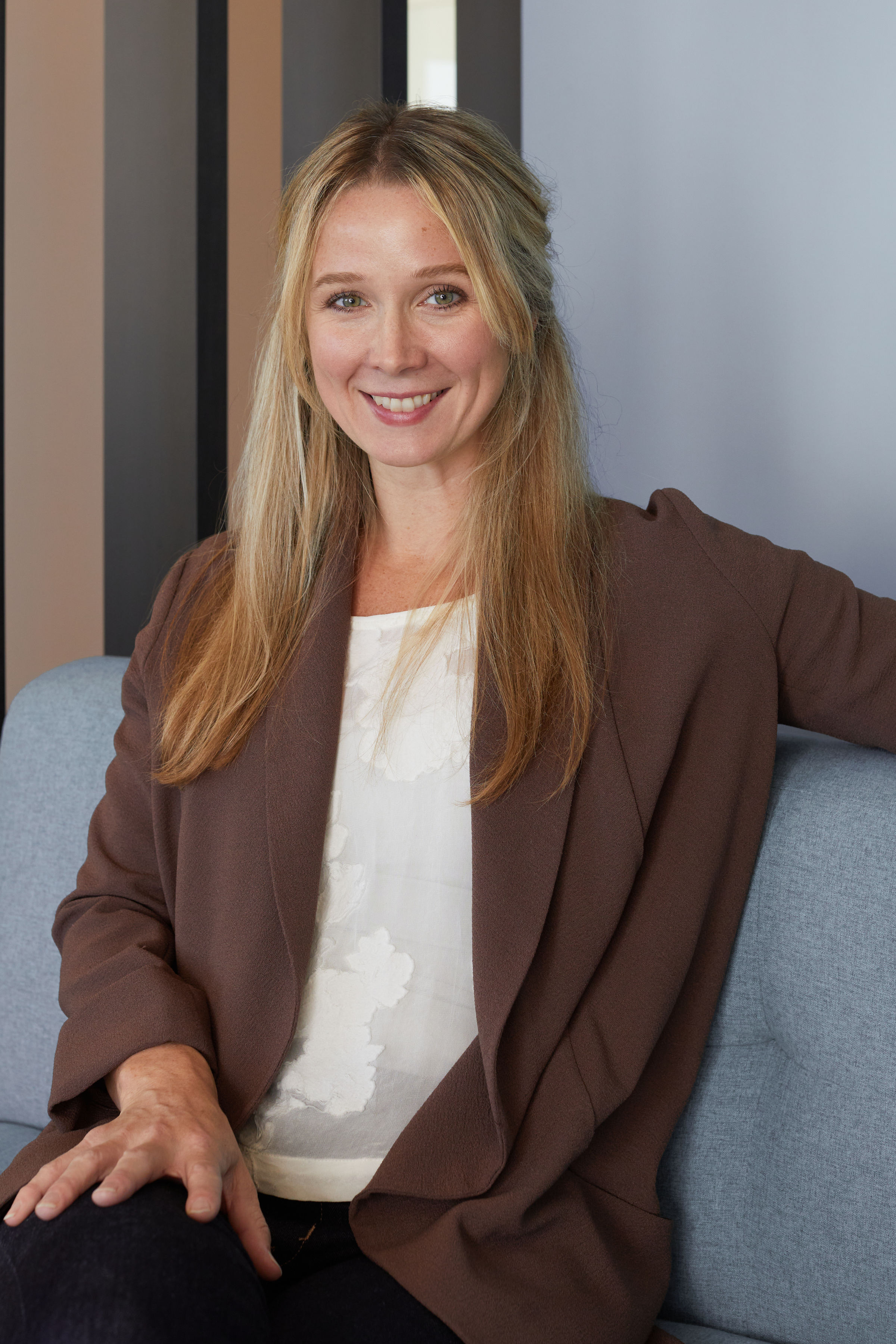
Emily Walsh
